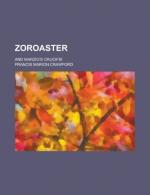But the queens hated each other with a fierce hatred, and when Darius was absent, their divisions broke out sometimes into something like open strife. Their guards buffeted each other in the courts, and their slave-women tore out each other’s hair upon the stairways. Then, when the king returned, there reigned an armed peace for a time, which none dared break. But rumours of the disturbances that had taken place often reached the royal ears, and Darius was angry and swore great oaths, but could do nothing; being no wiser than many great men who have had to choose between the caprices of two women who hated each other.
Now the rumour went abroad that Zoroaster would return to the court; and for a space, the two queens kept aloof, for both knew that if he came back, some mortal conflict would of necessity arise between them; and each watched the other, and was cautious.
The days passed by, but no one answered the proclamation. No one had seen or heard of Zoroaster, since the night when he left the palace at Shushan. He had taken nothing with him, and had left no trace behind to guide the search. Many said he had left the kingdom; some said he was dead in the wilderness. But Nehushta sighed and took little rest, for do what she would, she had hoped to see him once more.
CHAPTER XV.
The interior of the temple was lighted with innumerable lamps, suspended from the ceiling, of bronze and of the simplest workmanship, like everything which pertained to the worship of Auramazda. In the midst, upon a small altar of black stone, stood a bronze brazier, shaped like a goblet, wherein a small fire of wood burned quietly, sending up little wreaths of smoke, which spread over the flat ceiling and hung like a mist about the lamps; before the altar lay a supply of fuel—fine, evenly-cut sticks of white pine-wood, piled in regular order in a symmetrical heap. At one extremity of the oblong hall stood a huge mortar of black marble, having a heavy wooden pestle, and standing upon a circular base, in which was cut a channel all around, with an opening in the front from which the Haoma juice poured out abundantly when the fresh milkweed was moistened and pounded together in the mortar. A square receptacle of marble received the fluid, which remained until it had fermented during several days, and had acquired the intoxicating strength for which it was prized, and to which it owed its sacred character. By the side of this vessel, upon a low marble table, lay a huge wooden ladle; and two golden cups, short and wide, but made smaller in the middle like a sand-glass, stood there also.
At the opposite end of the temple, before a marble screen which shielded the doorway, was placed a great carved chair of ebony and gold and silver, raised upon a step above the level of the floor.




